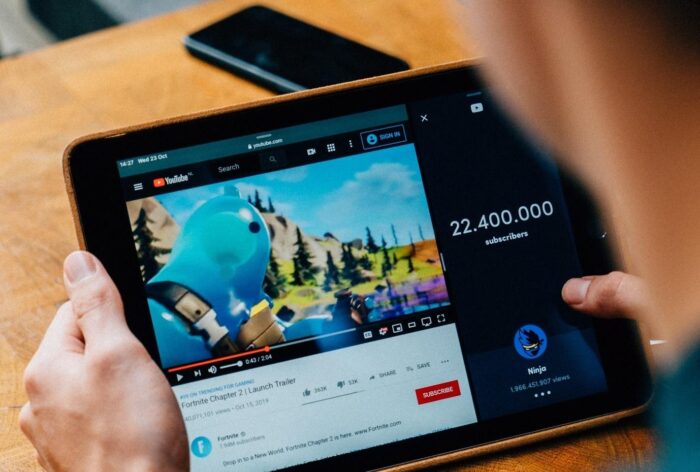How Do You Immerse Yourself in a Foreign Language From Home?
Read other articles:
Back to posts
Table of Contents
- 1 What is immersion learning?
- 2 Immersive learning from home…
- 2.1 Use the tech available
- 2.2 Listen to compelling content
- 2.3 Find online language partners to interact with
- 2.4 Avoid your native language as much as possible
- 2.5 Watch YouTube videos in your target language
- 2.6 Comment and engage on forums
- 2.7 Play games in your target language
- 2.8 Practice writing
- 2.9 Read content that interests you
- 2.10 Search out local communities
- 3 Immersive learning through video…

Immersive learning is often claimed to be one of the most effective methods of learning a foreign language.
This claim is backed up by studies that show that learning under immersion conditions may be more effective than typical classroom training and that students who are exposed to the language they’re learning through a bilingual immersion program or a study-abroad experience, exhibit higher levels of fluency.
One of the keys to effective language learning through immersion is motivation. If the learner is motivated to achieve a high level of proficiency, immersion techniques can be very effective.
However, one of the drawbacks of foreign language immersion is practical concerns: how do you immerse yourself in a language and culture without physically being in a country that speaks it?
That’s been aided greatly by the general move online. Students can now dive into a language without ever setting foot in a country or community that speaks it.
Let’s take a closer look at immersion and the many ways that you can absorb a language through it—without even leaving home.
What is immersion learning?
Immersion learning refers to the practice of placing students directly in a particular environment for the benefit of their education.
The most common use of immersion learning is in teaching foreign languages, where students surround themselves with the language and use it exclusively for interactions. This is designed to accelerate learning in the most natural way possible. In such situations, some degree of learning is usually inevitable—and, for highly motivated students, learning outcomes can be especially impressive.

The importance of all teacher instruction being in the target language is well-established and is a central pillar of Stephen Krashen’s theories on second language learning. That provides a degree of immersion within classrooms and more formal learning settings but foreign language immersion can also take place outside of the classroom in self-study situations without a teacher —where great strides can be made by committed learners.
Studying a language without structured learning requires a high degree of motivation but, to be most effective, it also requires engagement through input that is both comprehensible and interesting.
That’s predominantly what we consider in the next section… all you need is a good deal of motivation, a computer or smartphone, and a new way of thinking about how to learn a language.
Immersive learning from home…
So, how do we find immersive language experiences that are motivational, comprehensible, and interesting?
Here are a few ideas…
Use the tech available
Most younger learners don’t need to be told twice about this. They’re already using tech to immerse themselves in all types of experiences—from virtual reality games and augmented reality experiences to online communications with friends and loved ones.

Whether it’s through social media platforms, messaging apps or commenting on forum posts, interacting with people wherever they live is just something we do every day—without leaving home or the office.
Desktops, laptops, smartphones, and tablets can be used to watch, listen, record, photograph, and interact with all types of content in any language from anywhere. Breakfast at home before leaving for work can be an immersive learning experience. So too can the bus ride to and from the office.
Listen to compelling content
Whether it’s songs you like or podcasts on topics of interest, listening is an important skill for immersive language learners—it’s how a child starts learning.
Language teachers in classroom situations often focus too much on speaking and writing (output). As Stephen Krashen reminds us, input (listening and reading) is especially important as we build confidence in using the language we learn.
So, providing that what you’re listening to is mainly understandable (i.e., at the right level for your language proficiency), it will aid “passive” learning. Again, this is something you can do in bed, while eating dinner or during a commute.
Find online language partners to interact with
Not being able to travel to a country that speaks your target language used to be a big hindrance to immersive language learning—but not anymore. You can easily find people who speak the language you’re learning and interact with them in real time through social media, chat programs, video platforms, and so on.
Friendly conversational practice can help you use and acquire the language naturally outside of more formal language learning situations with teachers.

Once you’ve reached an intermediate level with your language, you’ll likely be more confident with using the language more freely and may want to seek out online language partners to practice speaking with. Skype Language Exchange, for instance, can help connect you with native speakers of your target language (even better if they want to learn your native language too).
Some learners even join language learning “clubs” to practice conversation with others. Check the likes of Meetup if you’re interested in doing this.
Avoid your native language as much as possible
Can you change your phone or smart TV language to your target language—or your Internet browser? Is it possible to select periods of the day when you only listen to, speak, read or write your target language?
The more you can place a temporary ban on using your native language, the more it will help you with the passive learning process, where you absorb and acquire language.
During more active learning times, instruction or content you’re watching should always be in the target language.
Watch YouTube videos in your target language
Language is most effectively acquired through comprehensible input on compelling topics in an anxiety-free environment.
The right YouTube videos, with native speakers and subtitled in the target language, can provide all of these essential ingredients of language success:
- Content for every level of language proficiency
- Topics to suit all interests
- Watch from home while munching on popcorn!

Video is perfect for self-motivated students prepared to immerse themselves in the language and culture they’re learning for hours on end. TV shows with consistent characters and repetitive storylines are ideal video content for learning a language but almost anything can work—movies, vlogs, music videos, news channels or, of course, language teacher channels.
Some language-learning apps can help with this process too, including our Chrome plugin that translates and explains phrases and allows you to build a library of new language learned from YouTube.
Comment and engage on forums
It seems that everywhere wants to hear from you online! Comments, forum posts, discussions, and so on are all opportunities to practice your target foreign language once you’ve gained reasonable confidence in using it.
Forums could be on any subject but are more likely to hold your interest if they are on topics you’re interested in and/or knowledgeable about.
Play games in your target language
Online gaming addict? Try switching to your target language and immersing yourself in the language that way.

Or if you just want to make your learning more fun, actively seek out games in your target language. Some of the language learning apps offer this option. Gamifying the learning process almost “tricks” the brain into believing it’s not learning but having fun instead!
Practice writing
Writing is another “output” task that moderate to advanced language learners may want to focus on for particular purposes.
The HiNative website allows you to submit writing in any language and have it corrected by a native speaker (or AI). In return, you may be able to correct a piece of writing in your native language.
Perhaps, start writing a journal in your target language—another excellent way to practice language through immersion, especially if you can have it corrected by native speakers.
Read content that interests you
Another way to immerse yourself in a language is to simply read books or online content that uses it.

This, along with watching videos and listening to content, is a good method for more introverted learners to get valuable exposure to the target language in a non-threatening, low-anxiety way. No output is required at all—simply absorb what you can from the language.
Finding books at the right comprehension level can be challenging—you may need to delve into the children’s sections, depending on your proficiency level.
Search out local communities
Wherever you live in the world, there will be communities of people speaking another language to the local one. An obvious example is Spanish speakers in the U.S. but everywhere has its pockets of language speakers who protect their culture.
If you’re learning one of the most popular languages (English, French, German, Spanish Portuguese, Mandarin, Russian, Arabic or Hindi) and live in a big city, chances are you’re not too far away from communities who speak it. So, if you do fancy leaving home to immerse yourself in your target language, don’t neglect this option!
Maybe you can do your groceries or laundry there so that you engage in the target language with business owners, customers, and other people. You could even volunteer to do some work in the community if there’s an opportunity— schools, medical facilities, and nonprofits are good starting places.

Immersive learning through video…
If you’re a motivated language learner with online access and a little time to spare, you can learn a foreign language quite happily from the comfort of your home.
You have all the tools you need for immersive learning at your fingertips—not least of which is YouTube video.
Combined with our free Chrome browser extension that you can download here, subtitled YouTube videos may be the “secret sauce” that gives your foreign language learning the ingredients you need for great leaps forward. You can learn how to use the app here.
Read other articles:
Back to posts
